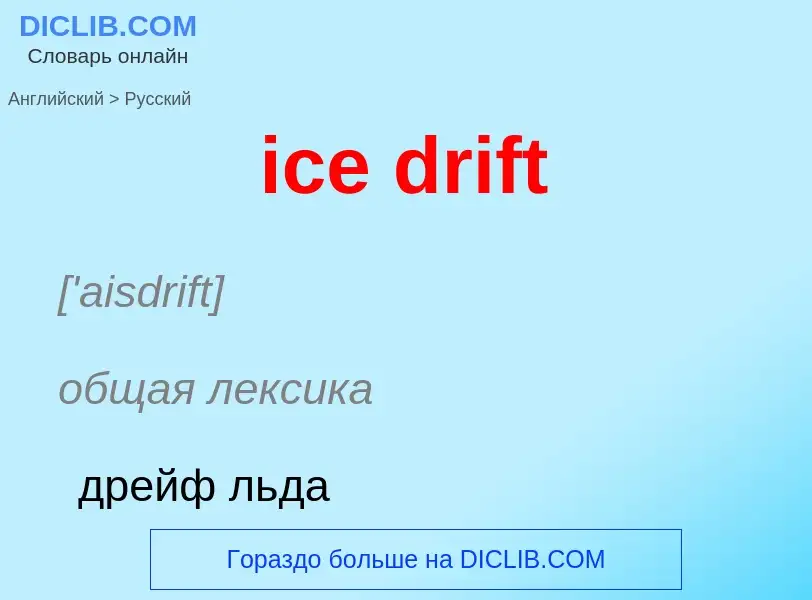Translation and analysis of words by artificial intelligence
On this page you can get a detailed analysis of a word or phrase, produced by the best artificial intelligence technology to date:
- how the word is used
- frequency of use
- it is used more often in oral or written speech
- word translation options
- usage examples (several phrases with translation)
- etymology
ice drift - translation to russian
['aisdrift]
общая лексика
дрейф льда
плавучие льды
торосы
нагромождение плавучего льда
ледяные поля
Definition
Wikipedia

Sea ice arises as seawater freezes. Because ice is less dense than water, it floats on the ocean's surface (as does fresh water ice, which has an even lower density). Sea ice covers about 7% of the Earth's surface and about 12% of the world's oceans. Much of the world's sea ice is enclosed within the polar ice packs in the Earth's polar regions: the Arctic ice pack of the Arctic Ocean and the Antarctic ice pack of the Southern Ocean. Polar packs undergo a significant yearly cycling in surface extent, a natural process upon which depends the Arctic ecology, including the ocean's ecosystems. Due to the action of winds, currents and temperature fluctuations, sea ice is very dynamic, leading to a wide variety of ice types and features. Sea ice may be contrasted with icebergs, which are chunks of ice shelves or glaciers that calve into the ocean. Depending on location, sea ice expanses may also incorporate icebergs.


![Rare phenomenon – the formation of ball ice. Stroomi Beach, [[Tallinn]], [[Estonia]]. Rare phenomenon – the formation of ball ice. Stroomi Beach, [[Tallinn]], [[Estonia]].](https://commons.wikimedia.org/wiki/Special:FilePath/Jää on kulmunud pallideks (Looduse veidrused). 05.jpg?width=200)
![As ice melts, the liquid water collects in depressions on the surface and deepens them, forming these melt ponds in the [[Arctic]]. These fresh water ponds are separated from the salty sea below and around it, until breaks in the ice merge the two. As ice melts, the liquid water collects in depressions on the surface and deepens them, forming these melt ponds in the [[Arctic]]. These fresh water ponds are separated from the salty sea below and around it, until breaks in the ice merge the two.](https://commons.wikimedia.org/wiki/Special:FilePath/Ponds on the Ocean, ICESCAPE.jpg?width=200)
![Satellite image of sea ice forming near [[St. Matthew Island]] in the Bering Sea Satellite image of sea ice forming near [[St. Matthew Island]] in the Bering Sea](https://commons.wikimedia.org/wiki/Special:FilePath/Seaice.jpg?width=200)
![lead]]s. (Scale not available.) lead]]s. (Scale not available.)](https://commons.wikimedia.org/wiki/Special:FilePath/Sea ice near coast of Labrador -a.jpg?width=200)
![lead]] developing in the centre.(Scale not available.) lead]] developing in the centre.(Scale not available.)](https://commons.wikimedia.org/wiki/Special:FilePath/Ikaasaartik-strait-icefloes-aerial.jpg?width=200)



![Sea ice off [[Baffin Island]] Sea ice off [[Baffin Island]]](https://commons.wikimedia.org/wiki/Special:FilePath/Sea Ice off Baffin Island.jpg?width=200)
![Sea ice imitates the shoreline along the [[Kamchatka Peninsula]]. Sea ice imitates the shoreline along the [[Kamchatka Peninsula]].](https://commons.wikimedia.org/wiki/Special:FilePath/Sea Ice Imitates the Shoreline along the Kamchatka Peninsula.jpg?width=200)
![Clear view of the [[Antarctic Peninsula]], the [[Larsen Ice Shelf]] and the sea ice-covered waters around the region Clear view of the [[Antarctic Peninsula]], the [[Larsen Ice Shelf]] and the sea ice-covered waters around the region](https://commons.wikimedia.org/wiki/Special:FilePath/Antarctic Peninsula, the Larsen Ice Shelf, and the sea ice covered waters around the region.jpg?width=200)
